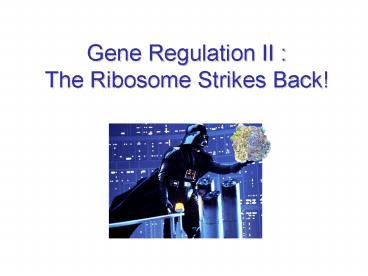Gene Regulation II : The Ribosome Strikes Back - PowerPoint PPT Presentation
Title:
Gene Regulation II : The Ribosome Strikes Back
Description:
Tryptophan Biosynthesis. Translational Control. RBS strength. Mechanisms that ... Low Tryptophan Levels: Slow translation of leader peptide from Domain 1 ... – PowerPoint PPT presentation
Number of Views:73
Avg rating:3.0/5.0
Title: Gene Regulation II : The Ribosome Strikes Back
1
Gene Regulation II The Ribosome Strikes Back!
2
Mechanisms Covered
- Attenuation Control
- Tryptophan Biosynthesis
- Riboswitches
- Tryptophan Biosynthesis
- Translational Control
- RBS strength
- Mechanisms that prevent translation
3
Attenuation Control
- Relies on the fact that in Bacteria transcription
and translation are coupled. - They occur at the same time! (Draw Diagram)
- Allows translational machinery to effect
transcription
4
Attenuation Control
- Low Tryptophan Levels
- Slow translation of leader peptide from Domain 1
- This allows hairpin formation between Domains 2
and 3 - Transcription continues
- High Tryptophan Levels
- Fast translation of leader peptide from Domain 1
- Domain 2 blocked by ribosome
- Hairpin formation between Domains 3 and 4 lead to
formation of terminator structure!
5
Alternative RNA Folding Dictates Termination
Properties
5 Region of trp operon transcript
6
Riboswitches
- Riboswitches are structures in mRNA that regulate
gene expression - up to now only found in bacteria
- Riboswitches are bound directly by small ligands
- vitamins, such as riboflavin, thiamin and
cobalamin - amino acids, such as methionine and lysine
- purine nucleotides (adenine, guanine)
- The binding of such ligands affects the secondary
structure of mRNA containing the riboswitch and
thus exerts a regulatory function - Riboswitches are probably one of the oldest
regulatory systems
7
Riboswitch Structures
- All known riboswitches fold into compact RNA
secondary structures with a base stem, a central
multi-loop and several branching hairpins
8
Riboswitch Mechanism I
- Riboswitches form a defined three-dimensional
conformation capable of specifically binding a
low molecular ligand (such as an amino acid,
vitamin or nucleotide) - Binding of the ligand stabilizes one particular
three-dimensional conformation of the riboswitch - If no ligand is bound a different
three-dimensional conformation of the riboswitch
becomes energetically more favourable and is
adopted - The different conformations (i.e., in absence or
presence of ligand) have different functional
consequences!
9
Riboswitch Mechanism II
Vitreschak et al., (2003). Riboswitches the
oldest mechanism for the regulation of gene
expression? Trends Genet. 20, 44-50.
10
Gene Regulation
- Mostly performed at the transcription level in
bacteria such as E.coli - IE John Cs lecture on gene regulation
- However it is possible to regulate at higher
levels - Eg. Translation (RNA -gt Protein)
- Eg. Post-translational modification (Protein -gt
Active Protein)
11
Translational Control in Bacteria
- Strength of ribosome-binding sites (RBSs) this
is especially important in bacterial
polycistronic messages where different amounts of
proteins need to be synthesized from a single
mRNA
Note the different lengths and position of the
RBSs!
12
Translational Control in Bacteria
- Other examples of translational control
- Translational repression occurs when excess
ribosomal proteins bind to their own mRNAs to
represses their translation. If there is
sufficient rRNA, these proteins will bind to it
in preference to the mRNA - The stringent response and attenuation (trp
operon and other amino acid biosynthetic operons)
are both negative control mechanisms that operate
through the ribosome to reduce transcription
13
Translational Control in Bacteria
- A final example of translational control
- Riboswitches do not only regulate transcription
but can also control the translation efficiency
of an mRNA - They do this by controlling access to the
Ribosome Binding (RBS) sequence - If the RBS is hidden, ribosomes will not be
recruited at all (or very inefficiently) and thus
the mRNA will not be effectively translated
14
Controlling Ribosome Recruitment through RBS
Accessibility
Ligand
Ribosomes get recruited (via RBS) to mRNA -gt
efficient translation
Ribosomes cannot get recruited to mRNA -gt no
translation































